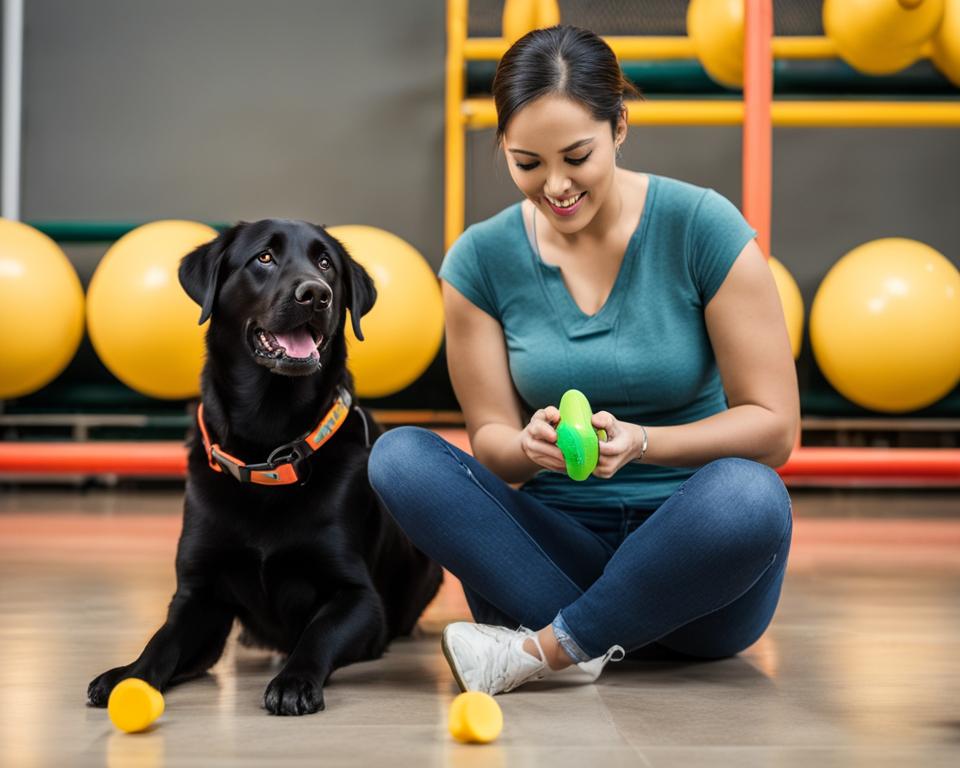Welcome to our comprehensive guide on the essentials of effective pet training! Whether you have a new puppy, a mischievous cat, or a furry friend who needs a refresher on obedience, this article is here to help. Training your pet is a vital part of nurturing a well-behaved and harmonious relationship. In this section, we will explore the tips and techniques necessary for successful pet training.
When it comes to training your pet, there are several key factors to keep in mind. From positive reinforcement techniques to behavior modification principles, we will provide insights on the most effective methods to shape your pet’s behavior. It’s important to remember that consistency is key when it comes to training. By establishing a routine and using positive reinforcement, you can set your pet up for success and foster a strong bond.
Key Takeaways:
- Training your pet for success requires consistency and positive reinforcement.
- Behavior modification principles are essential in shaping your pet’s behavior.
- Understanding your pet’s unique needs is crucial for tailoring your training approach.
- The positive reinforcement training method is highly effective in promoting good behavior.
- Creating a positive training environment and setting realistic goals are key starting points for successful pet training.
Understanding the Basics of Pet Training
When it comes to pet training, understanding the basics is essential for success. By laying a solid foundation, you can effectively communicate with your pet and shape their behavior in a positive way. In this section, we will explore the key elements of pet training, including identifying your pet’s unique needs, behavior modification principles, and the role of consistency in training.
Identifying Your Pet’s Unique Needs
Just like humans, each pet has their own personality and preferences. It’s crucial to identify and understand your pet’s unique needs to tailor your training approach accordingly. Take into consideration factors such as their breed, age, and individual temperament. This will help you choose the most suitable training techniques and methods that align with your pet’s specific requirements.
Behavior Modification Principles
Behavior modification is a critical aspect of pet training. It involves shaping and modifying your pet’s behavior by rewarding desirable actions and discouraging unwanted behaviors. By using positive reinforcement techniques, such as treats, praise, and play, you can motivate your pet to exhibit the desired behaviors consistently. It’s important to focus on rewarding behaviors you want to reinforce rather than punishing or scolding your pet for unwanted actions.
The Role of Consistency in Training
Consistency is key when it comes to pet training. By establishing clear rules and routines, you provide your pet with a structured learning environment. Consistency helps your pet understand what is expected of them and reinforces their training progress. Whether it’s practicing commands, enforcing boundaries, or maintaining a consistent reward system, being consistent in your approach will lead to more effective and lasting results.
In the next section, we will dive deeper into the positive reinforcement training method and explore its benefits in pet training. Understanding the power of positive reinforcement and how to implement it effectively will further enhance your training sessions and strengthen the bond between you and your pet.
The Positive Reinforcement Training Method
The positive reinforcement training method is widely regarded as one of the most effective approaches in pet training. It involves using rewards and positive feedback to encourage desired behaviors and discourage undesirable ones. This method focuses on the principle that animals are more likely to repeat behaviors that are followed by positive outcomes.
Benefits of Positive Reinforcement
There are numerous benefits to using positive reinforcement techniques in pet training:
- Increased Motivation: Positive reinforcement creates a positive and enjoyable learning experience for your pet, making them more motivated to participate in training sessions.
- Enhanced Bond: By using rewards and positive reinforcement, you build a strong bond of trust and communication with your pet. They associate you with positive experiences and look forward to training sessions.
- Improved Behavior: Positive reinforcement helps shape desired behaviors while minimizing the occurrence of undesirable ones. It allows you to focus on reinforcing the behaviors you want to see more of in your pet.
Implementing Rewards in Training
Implementing rewards effectively is crucial for successful positive reinforcement training. The key is to choose rewards that are highly motivating for your pet and immediately follow the desired behavior. Here are some tips for implementing rewards:
- Choose the Right Rewards: Identify what motivates your pet, whether it’s treats, praise, playtime, or a combination. Experiment with different types of rewards to find what works best for your pet.
- Timing is Key: Deliver the reward immediately after your pet exhibits the desired behavior. This helps them make the connection between the behavior and the reward.
- Consistency: Be consistent in rewarding your pet for the desired behavior. This reinforces the behavior and helps your pet understand what is expected of them.
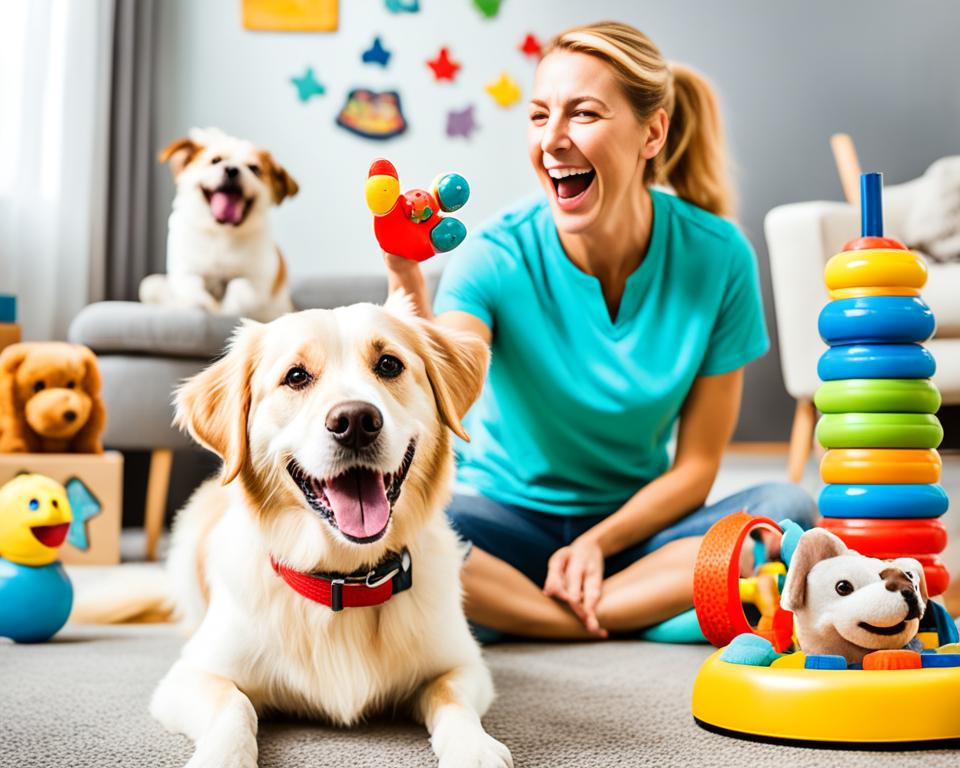
Training Your Pet for Success: Beginning Steps
Setting your pet up for training success starts with laying a strong foundation. By implementing the right beginning steps, you can create a positive training environment and establish a consistent routine that will set your pet on the path to success.
Here are some essential tips to help you get started:
- Establish a Consistent Routine: Consistency is key when training your pet. Set a regular schedule for feeding, sleeping, and playtime. This will help your pet understand what is expected of them and make it easier for them to learn and follow commands.
- Create a Positive Training Environment: Make sure the training environment is calm and free of distractions. Find a quiet space where you and your pet can focus on the training session without any interruptions. Use positive reinforcement techniques, such as treats and praise, to encourage desired behaviors and create a positive association with training.
- Set Realistic Goals: It’s important to set realistic goals for your pet’s training progress. Start with small, achievable tasks and gradually increase the difficulty as your pet becomes more proficient. Celebrate each milestone to keep your pet motivated and engaged in the training process.
Remember, patience and consistency are key when training your pet. With time and dedication, you will see progress and develop a strong bond with your furry companion.
Essential Pet Training Tools and Equipment
Having the right tools and equipment is crucial for effective pet training. In this section, we will discuss the essential pet training tools you’ll need to ensure successful training sessions with your furry friend.
Choosing the Right Crate for Crate Training
When it comes to crate training, selecting the right crate is essential for creating a safe and comfortable space for your pet. A crate provides a den-like environment where your pet can retreat to and relax. It also aids in housebreaking and preventing destructive behavior.
When choosing a crate, consider the following:
- Size: The crate should be large enough for your pet to stand up, turn around, and lie down comfortably.
- Material: Opt for durable and easy-to-clean materials, such as plastic or wire crates.
- Door Type: Consider the type of door, whether it’s a traditional swing door or a sliding door, based on your pet’s preference and ease of use.
Remember, crate training should always be a positive experience for your pet. Introduce the crate gradually, using treats and encouragement to make it a welcoming space.
Leash and Collar Selection
Leash and collar selection is crucial for leash training and ensuring your pet’s safety during walks and outdoor activities.
Consider the following when choosing a leash and collar:
- Material: Opt for durable materials like nylon or leather for both the leash and collar.
- Size and Fit: The collar should fit comfortably around your pet’s neck without being too loose or too tight. Measure your pet’s neck size and refer to the size guide for the appropriate fit.
- Leash Length: Choose a leash length that allows your pet to walk comfortably by your side.
- Leash Type: Consider different leash types, such as standard leashes or retractable leashes, based on your pet’s behavior and training needs.
Always ensure that the collar and leash are properly attached and secure before taking your pet for a walk. Regularly check the collar for any signs of wear and tear to prevent accidents.
Introducing Your Pet to Clicker Training
Clicker training is an effective communication tool that uses positive reinforcement to teach your pet desired behaviors.
Here’s how to introduce your pet to clicker training:
- Choose a suitable clicker: There are various types of clickers available, including handheld clickers and clickers incorporated into training aids. Select a clicker that is comfortable for you to use.
- Pair the sound with treats: Associate the sound of the clicker with a reward by clicking and immediately offering a treat. Repeat this several times to create a positive association.
- Start with simple commands: Once your pet understands that the clicker signifies a reward, begin using it during training sessions to mark desired behaviors. For example, click when your pet sits or responds to a command correctly. Follow each click with a treat.
- Consistency is key: Make sure to use the clicker consistently and follow every click with a reward. This will help reinforce the desired behaviors and strengthen the training process.
Remember, clicker training requires patience and consistency. With time and practice, your pet will learn to associate the clicker with positive experiences and eagerly respond to your commands.
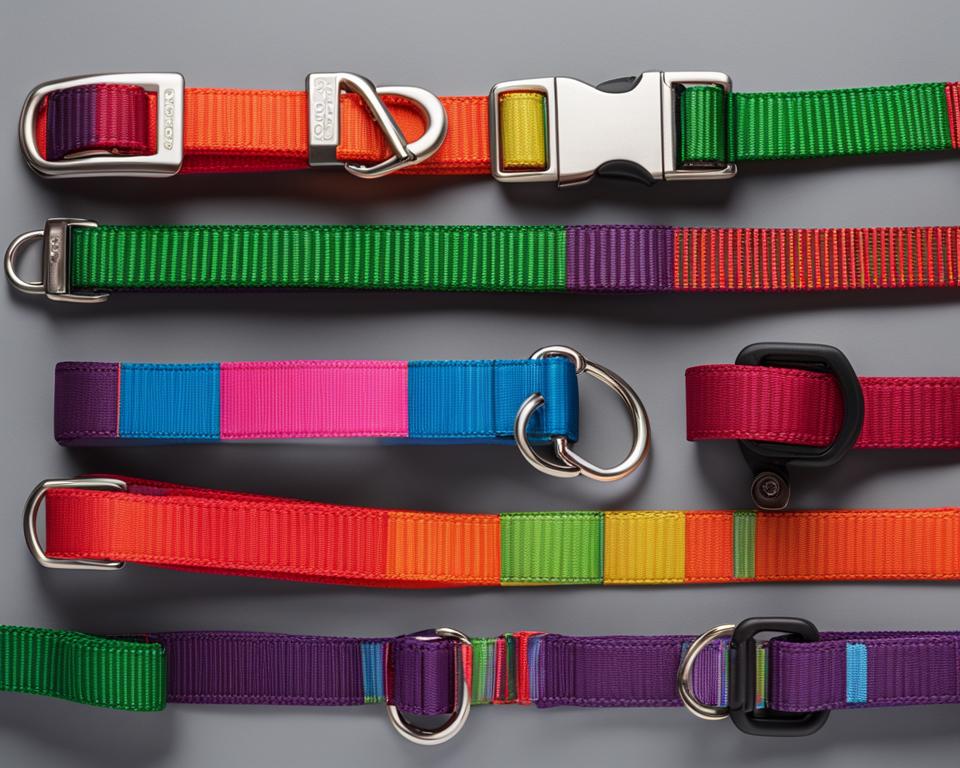
Leash Training Your Dog: Techniques for Obedience
Leash training is an essential aspect of dog obedience. It not only allows you to have control over your dog’s movements but also ensures their safety during walks. In this section, we will explore various techniques and methods to teach your dog to walk politely on a leash, respond to commands, and exhibit good leash manners.
One of the first steps in leash training your dog is to introduce them to the concept of wearing a leash. Start by attaching a lightweight leash to your dog’s collar or harness while they are in a familiar and comfortable environment. Allow them to explore and get accustomed to the feeling of the leash without any tension.
Once your dog is comfortable with wearing the leash, it’s time to start incorporating leash training exercises into your daily routine. Begin by walking in a controlled and calm manner, making sure to keep the leash loose. Avoid pulling or tugging on the leash, as this can create tension and resistance. Instead, use positive reinforcement techniques to reward your dog for walking beside you and maintaining a loose leash.
When leash training, it’s important to use consistent verbal cues and commands. For example, teach your dog the command “heel” or “walk” to signal them to stay by your side. Use treats or praise as rewards when they respond correctly to the command and walk nicely on the leash.
Another useful technique in leash training is the stop-start method. While walking, suddenly stop and wait for your dog to return to your side and sit down. Reward them for their compliance with treats or praise. This helps reinforce the behavior of walking on a loose leash and teaches your dog to pay attention to your movements.
It’s also important to address any pulling or lunging behavior during leash training. If your dog starts pulling on the leash, stop immediately and wait for them to return to your side. Only resume walking once they have stopped pulling and the leash is loose. Consistent application of this technique will help your dog associate pulling with the cessation of forward movement.
Remember, leash training takes time and patience. Consistency is key, so try to incorporate short leash training sessions into your daily routine. Over time, your dog will learn to walk politely on a leash, respond to commands, and exhibit good leash manners, making your walks more enjoyable for both of you.
Crate Training: Creating a Personal Space for Your Pet
Crate training is an effective method to provide your pet with a safe and secure environment. It offers numerous benefits, including promoting housebreaking, reducing anxiety, and ensuring your pet’s overall safety. Crate training can be an essential part of your pet’s training journey, helping them feel comfortable and protected in their own personal space.
Benefits of Crate Training
Crate training has several advantages for both you and your pet. Here are some key benefits:
- Housebreaking: Crates can aid in housebreaking your pet by teaching them to hold their bladder and bowels until they are taken outside.
- Reducing Anxiety: A crate provides a den-like environment that can help reduce anxiety and provide a safe retreat for your pet when they need a quiet place to relax.
- Preventing Destructive Behavior: When left unsupervised, pets can engage in destructive behaviors. Crate training can prevent this by keeping your pet confined to a safe space.
- Travel Safety: Crate training helps ensure your pet’s safety during travel, whether it’s a short car ride or a long journey.
By understanding the benefits of crate training, you can see how it can positively impact your pet’s behavior and well-being.
Step-by-Step Crate Training Guide
Follow these steps to effectively crate train your pet:
- Introduce the crate gradually: Make the crate inviting by placing soft bedding, toys, and treats inside. Allow your pet to explore the crate at their own pace.
- Encourage positive associations: Use treats and verbal praise to reward your pet when they willingly enter and stay in the crate. Repeat this process multiple times throughout the day.
- Lengthen crate time gradually: Start by closing the crate door for short periods, gradually increasing the duration as your pet becomes more comfortable.
- Establish a consistent routine: Stick to a schedule for crate time, meals, bathroom breaks, and exercise. Consistency is key to successful crate training.
- Use verbal cues: Introduce a specific command, such as “crate” or “kennel,” to associate with entering the crate. Use this command consistently during training.
- Progress to longer periods: Gradually extend the time your pet spends in the crate, ensuring they have frequent breaks for bathroom needs and exercise.
- Make the crate a positive experience: Regularly offer treats, toys, and praise when your pet is in the crate to reinforce positive associations.
- Never use the crate as punishment: The crate should always be a positive place for your pet. Never use it as a form of punishment.
Following this step-by-step crate training guide will help your pet develop a positive association with their crate and make it their own personal space.
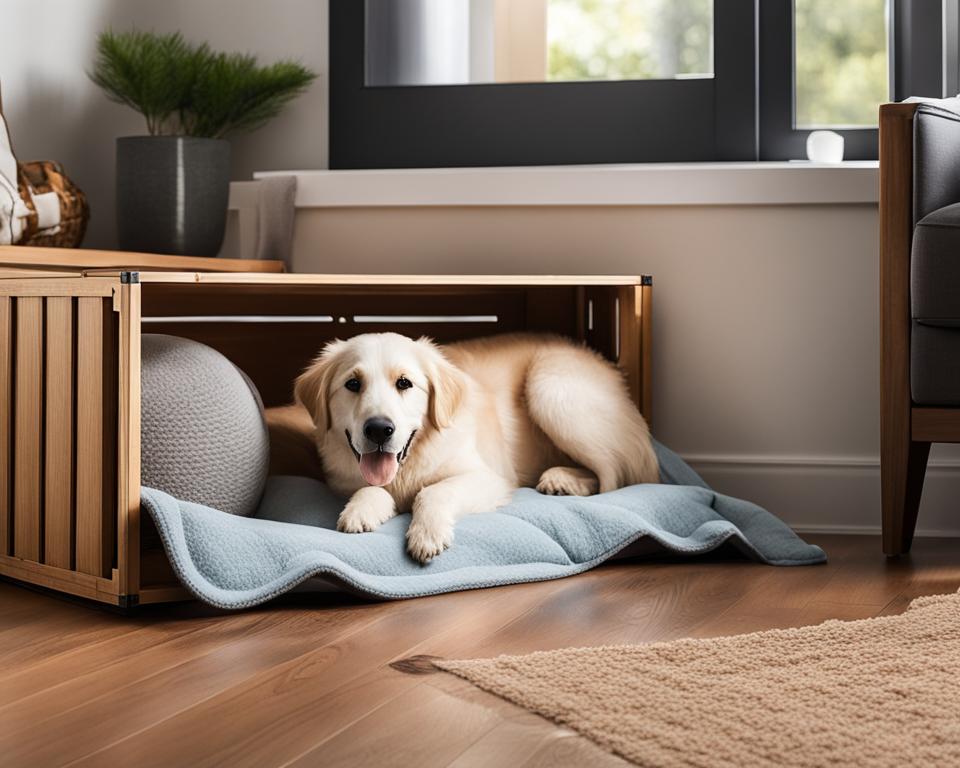
The Fundamentals of Puppy Training
Training puppies requires specific approaches and techniques to set them up for a lifetime of good behavior. In this section, we will explore the fundamentals of puppy training, including housebreaking and teaching basic commands that are crucial for their development and obedience.
Housebreaking Your Puppy
Housebreaking, also known as potty training, is an essential first step in puppy training. By teaching your puppy where and when to eliminate, you can prevent accidents and establish good hygiene habits. Here are some tips to help you housebreak your puppy:
- Create a designated potty area outside and consistently take your puppy there.
- Establish a regular feeding schedule to predict when your puppy will need to go potty.
- Use positive reinforcement, such as treats and praise, to reward your puppy for eliminating in the correct spot.
- Be patient and consistent, as housebreaking takes time and repetition.
Teaching Basic Commands
Teaching your puppy basic commands lays the foundation for further training and helps them become well-behaved companions. Here are some essential commands to start with:
- Sit: Teach your puppy to sit on command, which is useful for various situations and promotes impulse control.
- Stay: Train your puppy to stay in one place until given permission to move, which is crucial for their safety and obedience.
- Come: Teach your puppy to come to you when called, ensuring they respond promptly and reliably.
- Leave it: Train your puppy to leave objects or items on command, preventing them from picking up hazardous or inappropriate items.
Consistency, positive reinforcement, and regular training sessions are key to successfully teaching your puppy these basic commands. Remember to keep training sessions short and fun to maintain your puppy’s engagement and enthusiasm.
Cat Training: Yes, It’s Possible!
While often believed to be challenging, training cats is indeed possible. Cats are intelligent and can learn a variety of behaviors when provided with the right techniques and environment. In this section, we will explore effective techniques for cat training that can help you establish a positive and cooperative relationship with your feline companion.
One of the most effective methods for cat training is using positive reinforcement. This involves rewarding your cat for displaying the desired behavior through treats, praise, or play. By associating the behavior with a positive experience, your cat will be more motivated to repeat it.
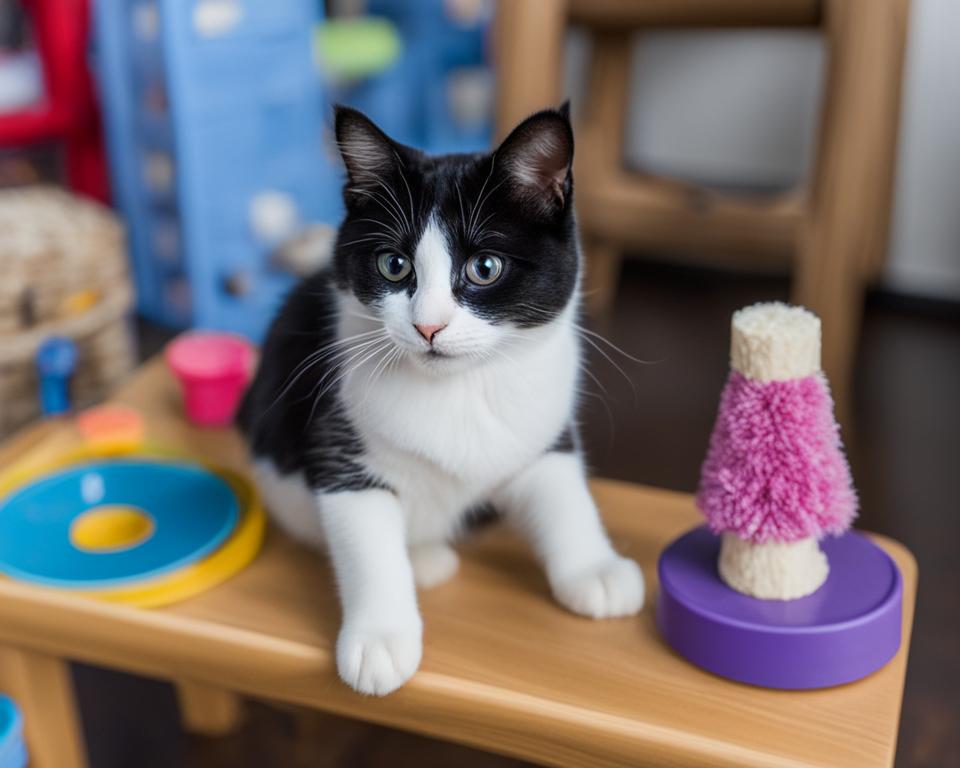
Another useful technique is clicker training. Clicker training involves using a clicker device to mark the desired behavior and then immediately rewarding your cat. This method helps establish clear communication and allows you to pinpoint and reinforce specific behaviors.
In addition to using these training techniques, creating a stimulating environment for your cat is crucial. Offer plenty of toys, scratching posts, and climbing structures to encourage exercise and mental stimulation. Providing regular playtime and interactive activities can also prevent boredom and promote positive behavior.
Remember, patience and consistency are key when training your cat. Cats have their own unique personalities and may require more time to adjust to new behaviors. With consistent reinforcement and a positive environment, you can successfully train your cat to exhibit desired behaviors and strengthen the bond between you.
Advanced Pet Training Techniques
Now that you have mastered the basics of pet training, it’s time to take it to the next level. In this section, we will explore advanced techniques that can help you address aggression and anxiety, master off-leash training, and expand your pet’s skills through trick training.
Addressing Aggression and Anxiety
Aggression and anxiety are common issues that many pet owners face. It’s important to address these behaviors to ensure the safety and well-being of both your pet and those around them. With advanced pet training techniques, you can help your pet overcome these challenges and develop more calm and confident behavior.
Some techniques you can use to address aggression and anxiety include:
- Desensitization and counter-conditioning
- Positive reinforcement training
- Behavior modification exercises
By working with a professional trainer or behaviorist, you can create a personalized training plan that targets the specific triggers and behaviors causing aggression and anxiety in your pet.
Off-Leash Training
Off-leash training allows your pet to have more freedom and independence while still maintaining control and obeying commands. However, it’s essential to ensure their safety and the safety of others when practicing off-leash training.
Here are some tips for effective and safe off-leash training:
- Start in a secure and enclosed area
- Progressively increase the level of distractions
- Use verbal cues and hand signals consistently
- Reward and reinforce good behavior
Off-leash training requires patience and consistency. Be sure to practice in different environments and gradually introduce new distractions to solidify your pet’s training.
Trick Training: Expanding Your Pet’s Skills
Trick training is a fun and engaging way to bond with your pet while expanding their skills and mental stimulation. Teaching your pet new tricks not only provides them with a challenge but also strengthens the bond between you and your pet.
Here are a few tricks you can teach your pet:
- Roll over
- High-five
- Play dead
- Fetch specific items
Trick training utilizes advanced pet training techniques such as shaping, capturing, and chaining behaviors to achieve the desired results. Keep your training sessions positive and rewarding, and always be patient with your pet’s progress.
By incorporating advanced pet training techniques, you can address aggression and anxiety, master off-leash training, and expand your pet’s skills through trick training. Remember to always prioritize safety, consistency, and positive reinforcement in your training sessions, and enjoy the journey of helping your pet reach their full potential.
Conclusion
Summarizing Effective Pet Training Strategies
Throughout this article, we have explored a range of effective pet training strategies to help you develop a harmonious relationship with your furry companion. By following these techniques, you can set your pet up for success and ensure long-term behavior improvements.
We have emphasized the importance of consistency in training. By establishing a consistent routine and using consistent commands, your pet will understand what is expected of them, leading to faster and more successful training outcomes.
Positive reinforcement has also been highlighted as a key strategy. This approach involves rewarding desired behaviors, such as following commands or exhibiting good manners. By praising and rewarding your pet with treats, playtime, or verbal affirmations, you can motivate them to repeat these positive behaviors.
Maintaining Training Success Long-Term
To maintain training success in the long term, it is important to continue practicing the techniques mentioned in this article. Regular training sessions, even after your pet has learned the basic commands, can reinforce good behavior and strengthen the bond between you and your pet.
Remember to be patient and understanding of your pet’s unique needs. Each pet is an individual, and their training journey may vary. By tailoring your training approach to suit their personality, temperament, and capabilities, you can achieve the best results.
In conclusion, effective pet training is built on consistency, positive reinforcement, and understanding your pet’s unique needs. By implementing these strategies and maintaining training efforts in the long term, you can establish a strong bond with your pet and cultivate desired behaviors that will make them a well-behaved and cherished member of your family.
FAQ
What are the basics of pet training?
The basics of pet training involve understanding your pet’s unique needs, implementing behavior modification principles, and being consistent in your training approach.
What is positive reinforcement training?
Positive reinforcement training is a technique that focuses on rewarding desired behaviors to increase motivation, strengthen the bond between pet and owner, and improve overall behavior.
How do I set my pet up for training success?
To set your pet up for training success, establish a consistent routine, create a positive training environment, and set realistic goals for your pet’s progress.
What tools and equipment do I need for effective pet training?
The essential tools and equipment for pet training include a suitable crate for crate training, the right leash and collar for obedience training, and a clicker for communication in clicker training.
How can I leash train my dog?
Leash training your dog involves teaching them to walk politely on a leash, respond to commands, and exhibit good leash manners. Various techniques and methods can be employed to achieve this.
What are the benefits of crate training?
Crate training provides a safe and secure space for your pet, promotes successful housebreaking, reduces anxiety, and ensures your pet’s safety when unsupervised.
How do I train a puppy?
Training a puppy requires a focus on housebreaking tips and methods, as well as teaching basic commands essential for their development and obedience.
Can cats be trained?
Yes, cats can be trained using techniques such as positive reinforcement, clicker training, and creating a stimulating environment to encourage desired behaviors.
What are some advanced pet training techniques?
Advanced pet training techniques include addressing aggression and anxiety in pets, ensuring off-leash training safety, and expanding your pet’s skills through trick training.

